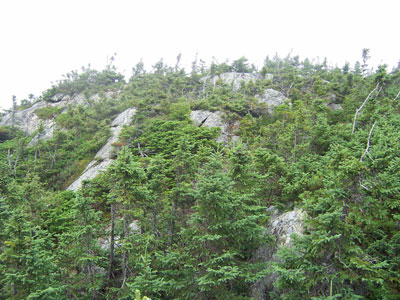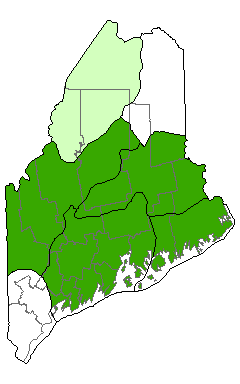DACF Home → Bureaus & Programs → Maine Natural Areas Program → Communities, Plants, and Animals → Natural Community Fact Sheets → Rocky Summit Heath
Printer Friendly Fact Sheet - 630 KB pdf (Get a free copy of Adobe Acrobat Reader)
Rocky Summit Heath
Scientific Name: Rocky Summit Heath; State Rank: S4

- Community Description
- Soil and Site Characteristics
- Diagnostics
- Similar Types
- Conservation, Wildlife and Management Considerations
- Distribution
- Characteristic Plants
- Associated Rare Plants
- Associated Rare Animals
- Examples on Conservation Lands You Can Visit
Community Description: Dwarf shrubs and stunted spruce or fir are the dominant features of this patchy vegetation. The tree layer is sparse (<25% cover) and includes balsam fir, red or black spruce, and (especially near the coast) northern white cedar. Dwarf shrub dominants vary and include Labrador tea, blueberries, and mountain cranberries. Interspersed islands of taller shrubs and stunted, wind flagged trees (<2 m tall) may grade to krummholz form. Herbs are patchy and less extensive than shrubs; three-toothed cinquefoil is usually present and often prominent. The bryoid layer is usually sparse (<30% cover), but may be more extensive in moist bedrock depressions. In these low spots, peat mosses are typical; otherwise, lichens are the dominant bryoids. Back to top.
Soil and Site Characteristics: Sites occupy upper slopes and ridges near the coast or mid-elevation balds (2,000'-3,000' inland). Soils are patchy, in bedrock pockets, consist of a thin layer (5-25 cm deep) of organic duff mixed with sand or rock fragments, and are acidic (pH 4.8-5.0) and excessively well drained, except in localized peaty pockets. Back to top.
Diagnostics: Tree cover is sparse, stunted, and patchy (<25% cover); balsam fir and heart-leaved paper birch are typical; red oak may occur at some coastal locations. Shrub cover is typically 10-50% at lower elevation sites or in pockets at higher elevations. Dwarf shrub cover exceeds herb cover, with lowbush blueberry or mountain cranberry prominent. Back to top.
Similar Types: Mid-elevation Balds occur at higher elevations but lack tree cover and feature crowberry, bilberry, and/or highland rush. Low-elevation Balds occur at similar elevations and may co-occur with Rocky Summit Heaths, but the former usually have herbaceous species exceeding dwarf shrub species in the herb layer. Other open summit communities occur at higher elevations and feature at least some strictly alpine species such as Bigelow's sedge, highland rush, diapensia, Lapland rosebay, etc. Spruce - Pine Woodlands are floristically similar and may co-occur but have >25% tree cover. Back to top.
Conservation, Wildlife and Management Considerations: Because this community type is usually associated with nice views, many sites have moderate to heavy hiker use. Off trail traffic can seriously degrade the vegetation, but at most sites the relatively dense shrub and conifer vegetation does not invite off trail wanderings. This type is well represented on public lands and private conservation lands.
This high-elevation dwarfed forest community type provides habitat for Bicknell's thrush, which only inhabits structurally complex forests above 2500'. Coniferous forest specialists like blackpoll warblers and spruce grouse are common associates in this community. Back to top.
Distribution: Western and coastal Maine (New England - Adirondack and Laurentian Mixed Forest Provinces), extending west into northern New England and New York and east into the Canadian Maritimes. Landscape Pattern: Small Patch. Back to top.


Characteristic Plants: These plants are frequently found in this community type. Those with an asterisk are often diagnostic of this community.
- Canopy
- Balsam fir*
- Sapling/Shrub
- Balsam fir*
- Gray birch*
- Mountain holly*
- Northern white cedar*
- Red spruce*
- Shadbush*
- Wild-raisin*
- Winterberry holly*
- Dwarf Shrub
- Black huckleberry*
- Labrador tea*
- Lowbush blueberry*
- Mountain cranberry*
- Rhodora*
- Sheep laurel*
- Herb
- Balsam fir*
- Three-toothed cinquefoil
- Bryoid
- Reindeer lichen
- Sphagnum mosses*
- Bicknell's thrush
Examples on Conservation Lands You Can Visit
| Example | County |
|---|---|
| Bald Mountain, Little Concord Pond Public Lands | Oxford Co. |
| Black Mountain, Donnell Pond Public Lands | Hancock Co. |
| Blueberry Mountain, White Mountain National Forest | Oxford Co. |
| Cadillac Mountain, Acadia National Park | Hancock Co. |
| Cold Brook Trail, White Mountain National Forest | Oxford Co. |
| Sargent Mountain, Acadia National Park | Hancock Co. |
| Tunk Mountain, Donnell Pond Public Lands | Hancock Co. |